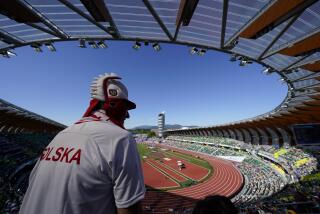Toe Protest? It Had to Be Luge : Controversy: Austrians lead after two runs. U.S., Italy question whether their uniforms improperly aid toe pointing.
- Share via
LA PLAGNE, France — Proving there is nothing like a little controversy to warm up the luge track, the United States and Italy protested here Tuesday that Austria’s women were improperly pointing their toes.
Lugegate?
Toe pointing may not sound like much but in luging, it affects the aerodynamics of the sled and is strictly regulated. And by sheer coincidence, the top three lugers after Tuesday’s two runs were Austrian.
But after a 45-minute debate, a three-man jury that included Bob Hughes, U.S. luge marketing director, decided not to slap the Austrians’ wrists, or their toes, much less disqualify them.
Whatever they were doing, sisters Doris and Angelika Neuner and Austrian teammate Andrea Tagwerker are obviously pointed in the right direction going into today’s final two runs.
Cammy Myler, the top U.S. luger, was in sixth place, Erica Terwillegar was eighth and Bonny Warner 18th.
Myler, of Lake Placid, N.Y., still has a shot at a medal, according to U.S. Coach Wolfgang Schaedler, who said she was weakened by a stomach problem.
“That’s probably not the best before a race like this,” he said.
But what the Austrians were doing wasn’t too good either, the United States and Italians insisted, so they filed a written protest.
The controversy involved the way the Austrian lugers wore their uniforms. According to the protesters, the Austrians hooked their suits under their heels in a manner that pointed the toes inward.
New luge rules forbid mechanical or elastic devices that point the toe, giving a slider an aerodynamic edge.
But the jury found no violation.
“I don’t think it helped them,” said Hughes, who inspected the uniforms.
“Personal opinion, I’m surprised the Austrians tried it,” he said. “It’s not worth taking the chance. If they had lost (the protest) today, they would have had three girls out of medals.”
Hughes said protests are common in luge racing.
“This isn’t like baseball, when you might have one or two or three protests a season,” Hughes said. “You can have three or four or five protests in a single luge race.”
Myler must hope that the five sledders in front of her slow down today, or that she can go faster, so she can make up some ice on them. It isn’t inconceivable. Myler, who finished second in the World Cup season, trails Tagwerker by 0.24 of a second for the bronze.
Myler declined to comment after the race, but Schaedler remained optimistic.
“The bronze medal will still be possible,” he said.
Myler was fifth after the first heat, but dropped a spot after the second heat, making what Schaedler called “a security run . . . maybe she should have pushed a little harder.”
Terwillegar, also of Lake Placid, retired after the 1988 Olympic Games but came back in 1990. She said her goal was to finish in the top 10. She didn’t want to be drawn into a discussion of the Austrian uniforms. “I tried not to pay any attention to it,” she said. “I don’t think it’s any advantage anyway.”
Today’s final two runs are the last for Warner, a Mt. Baldy native now living in Palo Alto. She is hanging up her sled after the Games here to concentrate on her career as an airline flight technician. Her sixth-place finish at Calgary in 1988 ranks as the highest for a U.S. luger, man or woman, in the Olympics.
Warner didn’t expect to place high in her farewell performances, so she found little wrong with her two runs.
“At least I didn’t hit the wall,” she said. “I didn’t screw up.”
More to Read
Go beyond the scoreboard
Get the latest on L.A.'s teams in the daily Sports Report newsletter.
You may occasionally receive promotional content from the Los Angeles Times.






